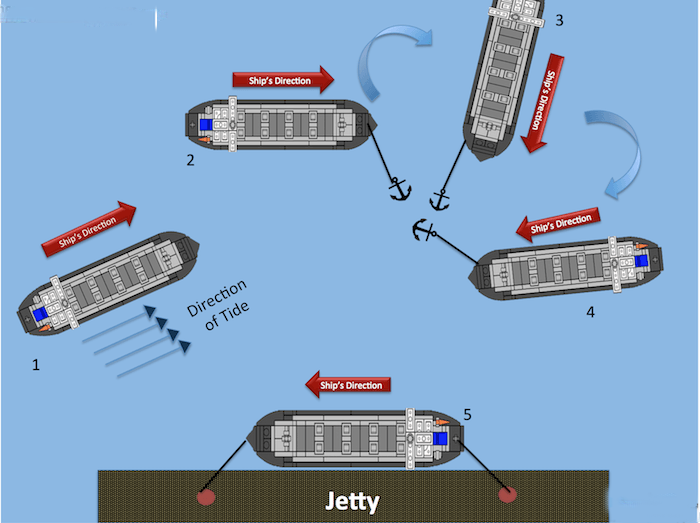Using mooring anchors to berth ships
The role of mooring anchors is crucial when docking a ship next to a pier or wharf in tidal or windy weather. Anchoring a ship is a scientific form because it involves the sense of pivot around which the ship rotates and exerts a stalling force on the ship.
In addition, the ship must always be close to the berth or dock where the tide is docked (by cutting off the tide to reduce the impact of the tide) to ensure better control of the ship. If the opposite operation is done while berthing if the ship approaches the berth or wharf when the stern is in the tide, the rudder effect will be minimized as the tide wanders the stern.
The process of berthing ships
In order to steer the ship that enters the tide port with the tide, the anchor is placed on the side of the ship that must be turned. If you plan to open the ship to the starboard side, the starboard anchor will fall. Similarly, if you plan to open the port wheel, the port anchor will drop. This is done to prevent the chain from going over the stern after swinging.
But before lowering the anchor, the ship’s speed will be reduced to 3 knots or less to minimize the chance of chain damage or damage to the ship’s equipment and hull.
For ships with normal right-handed propellers (falling with the tide), the starboard anchors are dropped to take advantage of the tilt, that is, the stern swing action is used to move forward or backward due to lateral thrust (essentially a lateral force) Stern). The boat is raised with the help of the anchor (ie, her way has stopped and the boat is only riding on its anchor).
Generally, in order to obtain the maximum anchor retention force, the length of the total anchor rod (the ship is made of chains, cables, ropes, or a combination of them, connected to the anchor rod through the rod) should be 4 to 7 times the length of the anchor rod. The depth of water at which the boat will be anchored.
Mooring anchors design
If the anchor is designed to withstand horizontal tension (such as flail or claw anchor), more chains can be added to reduce the pull angle, and the chain sag will provide sufficient catenary effect to secure the boat. The final position of the ship is pre-assessed in order to maintain sufficient leverage.
After the anchor resistance ceases, the rudder will continue to remain on the starboard side, and the tide will begin to push a quarter of the starboard side, rotating the ship 180° to the starboard side opposite the tide. After turning, weigh the anchor slowly. Then, by stopping the tide, the boat approached the pier at an angle of 20°-25° and passed the head rope.
If the tug can be used to assist in mooring, place the tug on the stern side of the other quarter of the stern. Rotate the bow with the head rope that has come ashore and has been “tightened” to bring the ship and the dock together, and gently push the stern with the tug until the stern line is safely ashore, and the second co-pilot has already begun to work hard.
If the head rope becomes too tight, minor slack or adjustments are given from the shore to prevent it from parting. If there is no tug in the vicinity, a jollyboat takes the line ashore from the stern. If the jollyboat is also unavailable, the ship’s stern is brought closer to the jetty with the help of the engines, with repeated slow kicks while pivoting the bow with the head-rope.
In this case, if the ship is equipped with a bow thruster and a stern thruster, the pilot will feel very lucky. These equipment tools make the pilot’s job easier.


